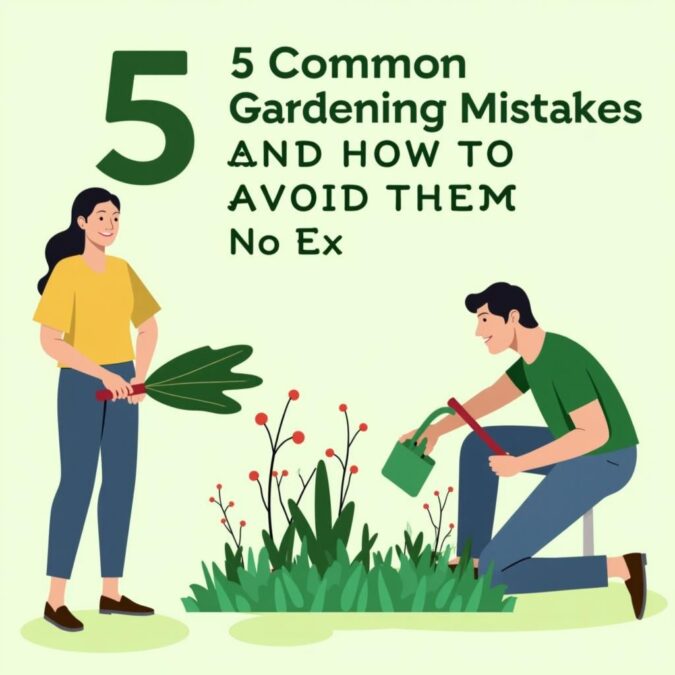5 Common Gardening Mistakes and How to Avoid Them
Gardening is a rewarding hobby that brings beauty, fresh produce, and a sense of accomplishment. However, even experienced gardeners can make mistakes that hinder their plants’ growth and health. Whether you’re a beginner or a seasoned green thumb, avoiding these common pitfalls can help you create a thriving garden. In this article, we’ll explore five common gardening mistakes and provide actionable tips on how to avoid them.
1. Overwatering or Underwatering Your Plants
One of the most common gardening mistakes is improper watering. Both overwatering and underwatering can have detrimental effects on your plants.

Why Overwatering is Harmful
Overwatering can lead to root rot, a condition where roots suffocate due to lack of oxygen. This can stunt plant growth and eventually kill the plant. Signs of overwatering include yellowing leaves, wilting, and soggy soil.

Why Underwatering is Harmful
Underwatering, on the other hand, deprives plants of essential moisture, causing them to wilt, dry out, and become more susceptible to pests. Symptoms include dry, brittle leaves and soil that pulls away from the edges of the pot.
How to Avoid This Mistake
- Check soil moisture: Use your finger or a moisture meter to test the soil before watering. Water only when the top inch of soil feels dry.
- Water deeply but less frequently: This encourages roots to grow deeper, making plants more resilient.
- Use well-draining soil: Ensure your soil has good drainage to prevent waterlogging.
2. Ignoring Soil Health
Healthy soil is the foundation of a thriving garden. Unfortunately, many gardeners overlook the importance of soil health, leading to poor plant growth.
Why Soil Health Matters
Soil provides essential nutrients, water, and support for plants. Poor soil quality can result in nutrient deficiencies, compacted roots, and inadequate drainage.
How to Improve Soil Health
- Test your soil: Use a soil test kit to determine pH levels and nutrient content.
- Add organic matter: Incorporate compost, manure, or leaf mold to enrich the soil.
- Rotate crops: Practice crop rotation to prevent soil nutrient depletion.
3. Planting in the Wrong Location
Choosing the right location for your plants is crucial for their success. Planting in the wrong spot can lead to poor growth and increased susceptibility to pests and diseases.
Common Location Mistakes
- Planting sun-loving plants in shaded areas.
- Placing shade-loving plants in direct sunlight.
- Crowding plants too closely together.
How to Choose the Right Location
- Understand plant needs: Research the light, space, and water requirements of each plant.
- Observe your garden: Note the amount of sunlight different areas receive throughout the day.
- Space plants properly: Follow spacing guidelines to ensure adequate air circulation and growth.
4. Neglecting Pest and Disease Control
Pests and diseases can wreak havoc on your garden if left unchecked. Ignoring early signs of infestation or infection can lead to widespread damage.
Common Pests and Diseases
- Aphids, spider mites, and whiteflies.
- Powdery mildew, blight, and root rot.
How to Prevent and Control Them
- Inspect plants regularly: Check for signs of pests or diseases, such as holes in leaves, discoloration, or wilting.
- Use natural remedies: Neem oil, insecticidal soap, and diatomaceous earth are effective and eco-friendly solutions.
- Practice good hygiene: Remove dead leaves and debris to reduce hiding spots for pests and pathogens.
5. Overfertilizing Your Plants
While fertilizing is essential for plant growth, overdoing it can cause more harm than good. Excessive fertilizer can lead to nutrient burn, root damage, and environmental pollution.
Why Overfertilizing is Harmful
Too much fertilizer can cause salt buildup in the soil, which damages plant roots and inhibits water uptake. It can also lead to excessive foliage growth at the expense of flowers or fruit.
How to Fertilize Properly
- Follow instructions: Always read and adhere to the recommended dosage on the fertilizer package.
- Use organic fertilizers: They release nutrients slowly and are less likely to cause harm.
- Monitor plant health: Adjust fertilization based on plant growth and appearance.
Conclusion
Gardening is a learning process, and mistakes are bound to happen. By being aware of these five common gardening mistakes, you can take proactive steps to avoid them and create a healthier, more productive garden. Remember, the key to success lies in understanding your plants’ needs and providing them with the right care. Happy gardening!







